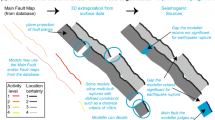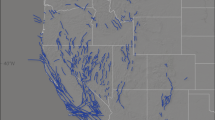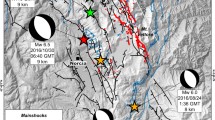Abstract
The Global Earthquake Model (GEM) aims to develop uniform, openly available, standards, datasets and tools for worldwide seismic risk assessment through global collaboration, transparent communication and adapting state-of-the-art science. GEM Faulted Earth (GFE) is one of GEM’s global hazard module projects. This paper describes GFE’s development of a modern neotectonic fault database and a unique graphical interface for the compilation of new fault data. A key design principle is that of an electronic field notebook for capturing observations a geologist would make about a fault. The database is designed to accommodate abundant as well as sparse fault observations. It features two layers, one for capturing neotectonic faults and fold observations, and the other to calculate potential earthquake fault sources from the observations. In order to test the flexibility of the database structure and to start a global compilation, five preexisting databases have been uploaded to the first layer and two to the second. In addition, the GFE project has characterised the world’s approximately 55,000 km of subduction interfaces in a globally consistent manner as a basis for generating earthquake event sets for inclusion in earthquake hazard and risk modelling. Following the subduction interface fault schema and including the trace attributes of the GFE database schema, the 2500-km-long frontal thrust fault system of the Himalaya has also been characterised. We propose the database structure to be used widely, so that neotectonic fault data can make a more complete and beneficial contribution to seismic hazard and risk characterisation globally.





Similar content being viewed by others

Notes
Neotectonic faults and folds are those that have been active in the current tectonic regime of a region. The time period will vary from region to region with longer time intervals required to characterise fault activity in low strain regions.
References
Ader T, Avouac J-P, Liu-Zeng J, Lyon-Caen H, Bollinger L, Galetzka J, Genrich J, Thomas M, Chanard K, Sapkota SN, Rajaure S, Shrestha P, Ding L, Flouzat M (2012) Convergence rate across the Nepal Himalaya and interseismic coupling on the Main Himalayan Thrust: implications for seismic hazard. J Geophys Res 117:B04403. doi:10.1029/2011JB009071
Albini P, Musson RMW, Gomez Capera AA, Locati M, Rovida A, Stucchi M, Viganò D (2013) Global historical earthquake archive and catalogue (1000-1903). GEM technical report 2013–01 V1.0.0, GEM Foundation, Pavia, Italy. 10.13117/GEM.GEGD.TR2013.01
Basili R, Valensise G, Vannoli P, Burrato P, Fracassi U, Mariano S, Tiberti MM, Boschi E (2008) The Database of Individual Seismogenic Sources (DISS), version 3: summarizing 20 years of research on Italy’s earthquake geology. Tectonophysics 453:20–43. doi:10.1016/j.tecto.2007.04.014
Basili R, Kastelic V, Valensise G, DISS Working Group 2009 (2009) Guidelines for compiling records of the Database of Individual Seismogenic Sources, version 3. DISS tutorial series, Instituto Nazionale di Geofisica e Vulcanologia
Basili R, Kastelic V, Demircioglu MB, Garcia Moreno D, Nemser ES, Petricca P, Sboras S P, Besana-Ostman GM. Cabral J, Camelbeeck T, Caputo R, Danciu L, Domac H, Fonseca J, García-Mayordomo J, Giardini D, Glavatovic B, Gulen L, Ince Y, Pavlides S, Sesetyan K, Tarabusi G, Tiberti MM, Utkucu M, Valensise G, Vanneste K, Vilanova S, Wössner J (2013) The European Database of Seismogenic Faults (EDSF) compiled in the framework of the Project SHARE. http://diss.rm.ingv.it/share-edsf/. doi:10.6092/INGV.IT-SHARE-EDSF
Berryman K, Ries W, Litchfield N (2014) The Himalayan frontal thrust: attributes for seismic hazard version 1.0, December 2014, GEM Faulted Earth project. http://www.nexus.globalquakemodel.org/
Berryman K, Wallace L, Hayes G, Bird P, Wang K, Basili R, Lay T, Pagani M, Stein R, Sagiya T, Rubin C, Barreintos S, Kreemer C, Litchfield N, Stirling MW, Gledhill K, Haller K, Costa C (2015) The GEM Faulted Earth subduction characterisation project, version 2.0, April 2015, GEM Faulted Earth project. http://www.nexus.globalquakemodel.org/gem-faulted-earth/posts
Bird P, Kagan YY (2004) Plate-tectonic analysis of shallow seismicity: apparent boundary width, beta, corner magnitude, coupled lithosphere thickness and coupling in seven tectonic regions. Bull Seismol Soc Am 94:2380–2399
Boettcher MS, Jordan TH (2004) Earthquake scaling relations for mid-ocean ridge transform faults. J Geophys Res 109:B12303. doi:10.1029/2004JB003110
Burrato P, Vannoli P, Fracassi U, Basili R, Valensise G (2012) Is blind faulting truly invisible? Tectonic-controlled drainage evolution in the epicentral area of the May 2012, Emiliae-Romagna earthquake sequence (northern Italy). Ann Geophys 55:4. doi:10.4401/ag-6182
Christophersen A, Berryman K, Litchfield N (2015) The GEM Faulted Earth project, version 1.0, April 2015, GEM Faulted Earth project. http://www.nexus.globalquakemodel.org/
Clark D, McPherson A, Van Dissen R (2012) Long-term behavior of Australian stable continental region (SCR) faults. Tectonophysics 566–567:1–30
Costa CH, Audemard MFA, Bezerra FHR, Lavenu A, Machette MN, Paris G (2006) An overview of the main Quaternary deformation of South America. Revista de la Asociacion Geologica Argentina 61:461–479
Costa C, Machette MN, Dart RL, Bastias HE, Paredes JD, Perucca LP, Tello, GE, Haller KM (2000) Map and database of Quaternary faults and folds in Argentina. USGS Open-File Report: 2000-108
Cowan H, Machette MN, Haller KM, Dart RL (1998) Map and database of Quaternary faults and folds in Panama and its offshore regions. United States Geological Survey Open-File Report 98-779
Cowan H, Machette MN, Amador X, Morgan KS, Dart RL, Bradley LA (2000) Map and database of Quaternary faults in the vicinity of Managua, Nicaragua. USGS Open-File Report: 2000-437
Crowley H, Pinho R, Pagani M, Keller N (2013) Assessing global earthquake risks: the Global Earthquake Model (GEM) initiative. Handb Seismic Risk Anal Manag Civil Infrastruct Syst. doi:10.1533/9780857098986.5.815
Audemard FA, Machette MN, Cox JW, Dart, RL, Haller KM (2000) Map and database of Quaternary faults in Venezuela and its offshore regions. USGS Open-File Report: 2000-18
DeMets C, Gordon RG, Argus DF (2010) Geologically current plate motions. Geophys J Int 181:1–80
DISS Working Group (2010). Database of individual seismogenic sources (DISS), version 3.1.1: a compilation of potential sources for earthquakes larger than M 5.5 in Italy and surrounding areas. http://diss.rm.ingv.it/diss/, © INGV 2010—Istituto Nazionale di Geofisica e Vulcanologia—All rights reserved; doi:10.6092/INGV.IT-DISS3.1.1
Eguez A, Alvarado A, Yepes H, Machette MN, Costa C, Dart RL (2003) Database and map of Quaternary faults and folds of Ecuador and its offshore regions. USGS Open-File Report 2003-289
EMME (2013). EMME—Earthquake Model of the Middle East region: hazard, risk assessment, economics & mitigation. http://www.emme-gem.org/
Field EH, Biasi GP, Bird P, Dawson TE, Felzer KR, Jackson DD, Johnson KM, Jordan TH, Madden C, Michael AJ, Milner KR, Page MT, Parsons T, Powers PM, Shaw BE, Thatcher WR, Weldon RJ, Zeng Y (2013) Uniform California earthquake rupture forecast, version 3 (UCERF3)—The time-independent model. U.S. Geological Survey Open-File Report 2013-1165, California geological survey special report 228, and Southern California Earthquake Center Publication 1792, http://pubs.usgs.gov/of/2013/1165/
Giardini D, Grünthal G, Shedlock KM, Zhang P (1999) The GSHAP global seismic hazard map. Annali di Geofisica 42(6):1225–1228
Gilbert GK (1884) A theory of the earthquakes of the Great Basin, with a practical application. Am J Sci 27(3):49–53. doi:10.2475/ajs.s3-27.157.49
Haller KM, Basili R (2011) Developing seismogenic source models based on geologic fault data. Seismol Res Lett 82:519–525
Haller KM, Machette MN, Dart RL (1993) Maps of major active faults, Western Hemisphere International Lithosphere Program (ILP) Project II-2: guidelines for U.S. Database and Map. USGS Open-File Report, vol 93–338
Hayes GP, Wald DJ, Johnson RL (2012) Slab1.0: a three-dimensional model of global subduction zone geometries. J Geophys Res 117:B01302. doi:10.1029/2011JB008524
Jongens R, Dellow G (2003) The active faults database of NZ: data dictionary. GNS science report 2003/17. Institute of Geological and Nuclear Sciences Limited, Lower Hutt
Kagan YY, Jackson DD (2013) Tohoku earthquake: a surprise? Bull Seismol Soc Am 103(2B):181–1194. doi:10.1785/0120120110
Koehler RD (2013) Quaternary faults and folds (QFF): Alaska Division of Geological & Geophysical Surveys Digital Data Series 3, http://maps.dggs.alaska.gov/qff/. doi:10.14509/24956
Koehler RD, Farrell RE, Burns PAC, Combellick RA (2012) Quaternary faults and folds in Alaska: a digital database. Alaska Division of Geological & Geophysical Surveys Miscellaneous Publication, Fairbanks, Alaska
Koto B (1893) On the cause of the great earthquake in central Japan. J Coll Sci Imp Univ Tokyo 5:295–353
Kreemer C, Blewitt G, Klein EC (2014a) A geodetic plate motion and global strain rate model. Geochem Geophys Geosyst. doi:10.1002/2014GC005407
Kreemer C, Klein EC, Shen ZK, Wang M, Estey L, Wier S, Boler F (2014b) Global geodetic strain rate model, GEM technical report 2014-07 V1.0.0, GEM Foundation, Pavia, Italy, doi:10.13117/GEM.GEGD.TR2014.07
Lavenu A, Thiele R, Machette MN, Dart RL, Bradley LA, Haller KM (2000) Map and database of Quaternary faults in Bolivia and Chile. USGS Open-File Report: 2000-283
Litchfield N, Thomas R (2013) Bulk upload of national and global databases, GEM Faulted Earth. www.nexus.globalquakemodel.org/gem-faulted-earth/posts/
Litchfield N, Berryman K, Stein R, Willis M (2011) Inventory of existing fault databases and data attributes, GEM Faulted Earth. www.nexus.globalquakemodel.org/gem-faulted-earth/posts/
Litchfield N, Berryman K, Thomas R (2013) Data Dictionary, GEM Faulted Earth. www.nexus.globalquakemodel.org/ gem-faulted-earth/posts/
Lyell C (1868) Principles of physical geology, 10th edn. John Murray, London
Machare J, Fenton CH, Machette MN, Lavenu A, Costa C, Dart RL (2003) Database and map of quaternary faults and folds in Peru and its Offshore Region USGS Open-File Report 2003-451
Machette M, Haller K, Wald L (2004) Quaternary fault and fold database for the nation, United States geological survey fact sheet 2004-3033
McCaffrey R (2008) Global frequency of magnitude 9 earthquakes. Geol 36(3):263–266
McGarvin TG (1987) The 1887 Sonoran earthquake: it wasn’t our fault. Ariz Bur Geol Min Technol Fieldnotes 17(2):1–2
McKay A (1890) On the earthquakes of September 1888, in the Amuri and Marlborough districts of the South Island. N Z Geol Surv Rep Geol Explor 20:1–16
Montero W., Denyer P, Barquero R, Alvarado GE, Cowan H, Machette MN, Haller KM, Dart RL (1998) Map and database of Quaternary faults and folds in Costa Rica and its offshore regions. United States Geological Survey Open-File Report 98-481
Moss RE, Ross ZE (2011) Probabilistic fault displacement hazard analysis for reverse faults. Bull Seismol Soc Am 101(4):1542–1553. doi:10.1785/0120100248
Nicol A, Robinson R, Van Dissen RJ, Harvison A (2012) Variability of single event slip and recurrence intervals for large magnitude paleoearthquakes on New Zealand’s active faults. GNS science report 2012/41
Pagani M, Monelli D, Weatherill G, Danciu L, Crowley H, Silva V, Henshaw P, Butler L, Nastasi M, Panzeri L, Simionato M, Vigano D (2014) OpenQuake Engine: an Open Hazard (and risk) Software for the Global Earthquake Model. Seismol Res Lett 85:692–702
Pagani M, Garcia J, Monelli D, Weatherill G, Smolka A (2015) A summary of hazard datasets and guidelines supported by the Global Earthquake Model during the first implementation phase. Submitted to Annals of Geophysics
Pantosti D, Berryman K, Yeats RS, Kinugasa Y (eds) (2003) Ten years of paleoseismology in the ILP: progress and prospects. Ann Geophys 46:733–1194
Paris G, Machette MN, Dart RL, Haller KM (2000) Map and database of Quaternary faults and folds in Colombia and its offshore regions. USGS Open-File Report: 2000-284
Parsons T, Console R, Falcone G, Murru M, Yamashita K (2012) Comparison of characteristic and Gutenberg–Richter models for time-dependent M ≥ 7.9 earthquake probability in the Nankai-Tokai subduction zone. Jpn Geophys J Int 190:1673–1688. doi:10.1111/j.1365-246X.2012.05595.x
Petersen MD, Frankel AD, Harmsen SC, Mueller CS, Haller KM, Wheeler RL, Wesson RL, Zeng Y, Boyd OS, Perkins DM, Luco N, Field EH, Wills CJ, Rukstales KS (2008) Documentation for the 2008 update of the national seismic hazard maps. USGS Open-file Report, vol 2008-1128
Pinho R (2012) GEM: a participatory framework for open, state-of-the-art models and tools for earthquake risk assessment worldwide. In: Proceedings of the 15th world conference on earthquake engineering, Lisbon, Portugal
Rong Y, Jackson DD, Magistrale H, Goldfinger C (2014) Magnitude limits of subduction zone earthquakes. Bull Seismol Soc Am 104(5):2359–2377. doi:10.1785/0120130287
Ruleman CA, Crone AJ, Machette MN, Haller KM, Rukstales KS (2007) Map and database of probable and possible Quaternary faults in Afghanistan. USGS Open-File Report, vol 2007–1103
Saadi A, Machette MN, Haller KM, Dart RL, Bradley LA, de Souza AMPD (2003) Map and database of Quaternary faults and lineaments in Brazil. USGS Open-File Report: 2002-230
Shimazaki K (1986) Small and large earthquakes: the effects of the thickness of seismogenic layer and the free surface. In: Das S, Boatwright J, Scholz CH (eds) Earthquake source mechanics, vol 37. AGU Monograph, pp 209–216
Shyu JBH, Sieh K, Chen YG, Liu CS (2005) Neotectonic architecture of Taiwan and its implications for future large earthquakes. J Geophys Res 110:B08402. doi:10.1029/2004JB003251
SSHAC (1997) Senior Seismic Hazard Analysis Committee, and Budnitz RJ. Recommendations for probabilistic seismic hazard analysis: guidance on uncertainty and use of experts, vol 1. US Nuclear Regulatory Commission, Washington
Stein RS, Barka AA, Dieterich JD (1997) Progressive failure on the North Anatolian fault since 1939 by earthquake stress triggering. Geophys J Int 128(3):594–604
Stirling M, McVerry G, Gerstenberger M, Litchfield N, Van Dissen R, Berryman K, Barnes P, Wallace L, Villamor P, Langridge R, Lamarche G, Nodder S, Reyners M, Bradley B, Rhoades D, Smith W, Nicol A, Pettinga J, Clark K, Jacobs K (2012) National seismic hazard model for New Zealand: 2010 update. Bull Seismol Soc Am 102(4):1514–1542
Stirling MW, Goded T, Berryman KR, Litchfield NJ (2013) Selection of earthquake scaling relationships for seismic hazard analysis. Bull Seismol Soc Am 103(6):2993–3011. doi:10.1785/0120130052
Storchack DA, Giacomo DD, Bondar I, Engdahl ER, Harris J, Lee WHK, Villasenor A, Bormann P (2013) Public release of the ISC-GEM global instrumental earthquake catalogue (1900–2009). Seismol Res Lett 84:810–815
Storchak DA, Giacomo D, Bondár I, Harris J, Engdahl ER, Lee WHK, Villaseñor A, Bormann P, Ferrari G (2012) ISC-GEM Global Instrumental Earthquake Catalogue (1900-2009). GEM Technical Report 2012-01 V1.0.0, GEM Foundation, Pavia, Italy. doi:10.13117/GEM.GEGD.TR2012.01
Thomas R (2012) GEM Faulted Earth database XML interchange. www.nexus.globalquakemodel.org/ gem-faulted-earth/posts/
Thomas R, Litchfield N, Christophersen A (2012) GEM Faulted Earth database design. www.nexus.globalquakemodel.org/ gem-faulted-earth/posts/
Trifonov GV, Machette MN (1993) The world map of major active faults project. Annali di Geofisica 36(3–4):225–236
U.S. Geological Survey (2006) Quaternary fault and fold database for the United States, accessed February 2013, from USGS web site: http://earthquakes.usgs.gov/regional/qfaults/
Villamor P, Ornthammarath T, Zúñiga R, Horspool N, Christophersen A, Langridge R (2013) Towards new active fault data, version 1.0, July 2013. GEM Faulted Earth Project, available from www.nexus.globalquakemodel.org/gem-faulted-earth/posts/
Wallace RE (1949) Structure of a portion of the San Andreas rift in southern California. Geol Soc Am Bull 60:781–806
Wellman HW, Willett RW (1942) The geology of the West coast from Abut head to Milford sound—part 1. Trans R Soc N Z 71:282–306
Wells DL, Coppersmith KJ (1993) Likelihood of surface rupture as a function of magnitude. Seismol Res Lett 64:54
Wells DL, Coppersmith KJ (1994) New empirical relationships among magnitude, rupture length, rupture width, rupture area, and surface displacement. Bull Seismol Soc Am 84(4):974–1002
Wesnousky SG (1986) Earthquakes, quaternary faults, and seismic hazard in California. J Geophys Res Solid Earth (1978–2012) 91(B12):12587–12631
Yeats R (2012) Active faults of the world. Cambridge University Press, Cambridge, England
Yeats RS, Prentice CS (1996) Introduction to special section; paleoseismology. J Geophys Res 101(B3):5847–5853
Yoshioka T, Awata Y, Shimokawa Y, Fusejima Y (2005) Explanatory text of the rupture probability map of major active faults in Japan. Tectonic map series 14, geological survey of Japan. AIST, Japan
Acknowledgments
Funding for the development of the GFE database was from the GEM Foundation. GNS Science supported the preparation of this manuscript. We thank Marco Pagani for his support for the overall GFE project, and Ben Wyss and Paul Henshaw and their team at the GEM Foundation for developing the web tool. We thank Andy Nicol, Russ Van Dissen, Jim Dewey and Pierfrancesco Burrato for their helpful reviews.
Author information
Authors and Affiliations
Corresponding author
Rights and permissions
About this article
Cite this article
Christophersen, A., Litchfield, N., Berryman, K. et al. Development of the Global Earthquake Model’s neotectonic fault database. Nat Hazards 79, 111–135 (2015). https://doi.org/10.1007/s11069-015-1831-6
Received:
Accepted:
Published:
Issue Date:
DOI: https://doi.org/10.1007/s11069-015-1831-6



